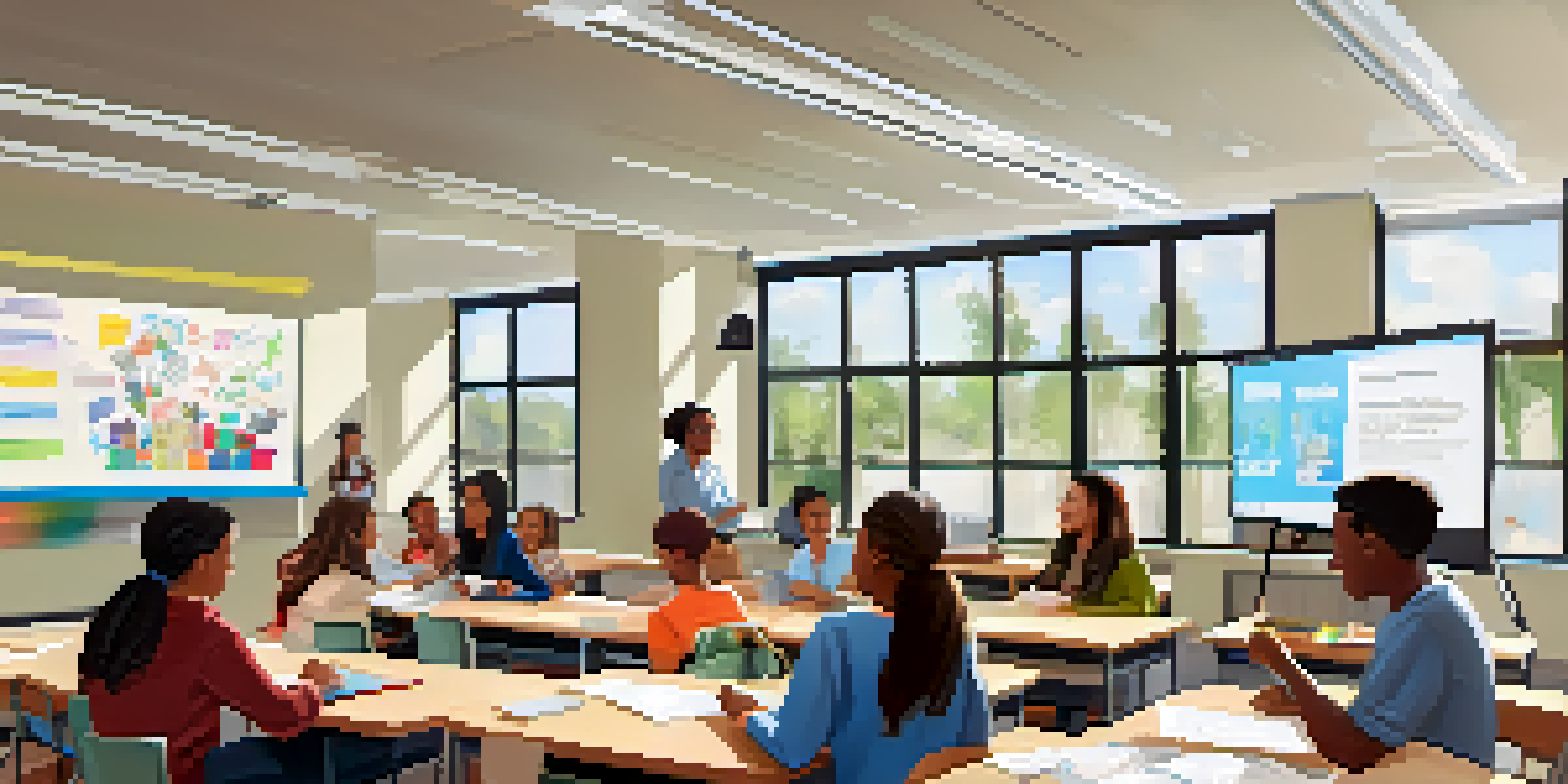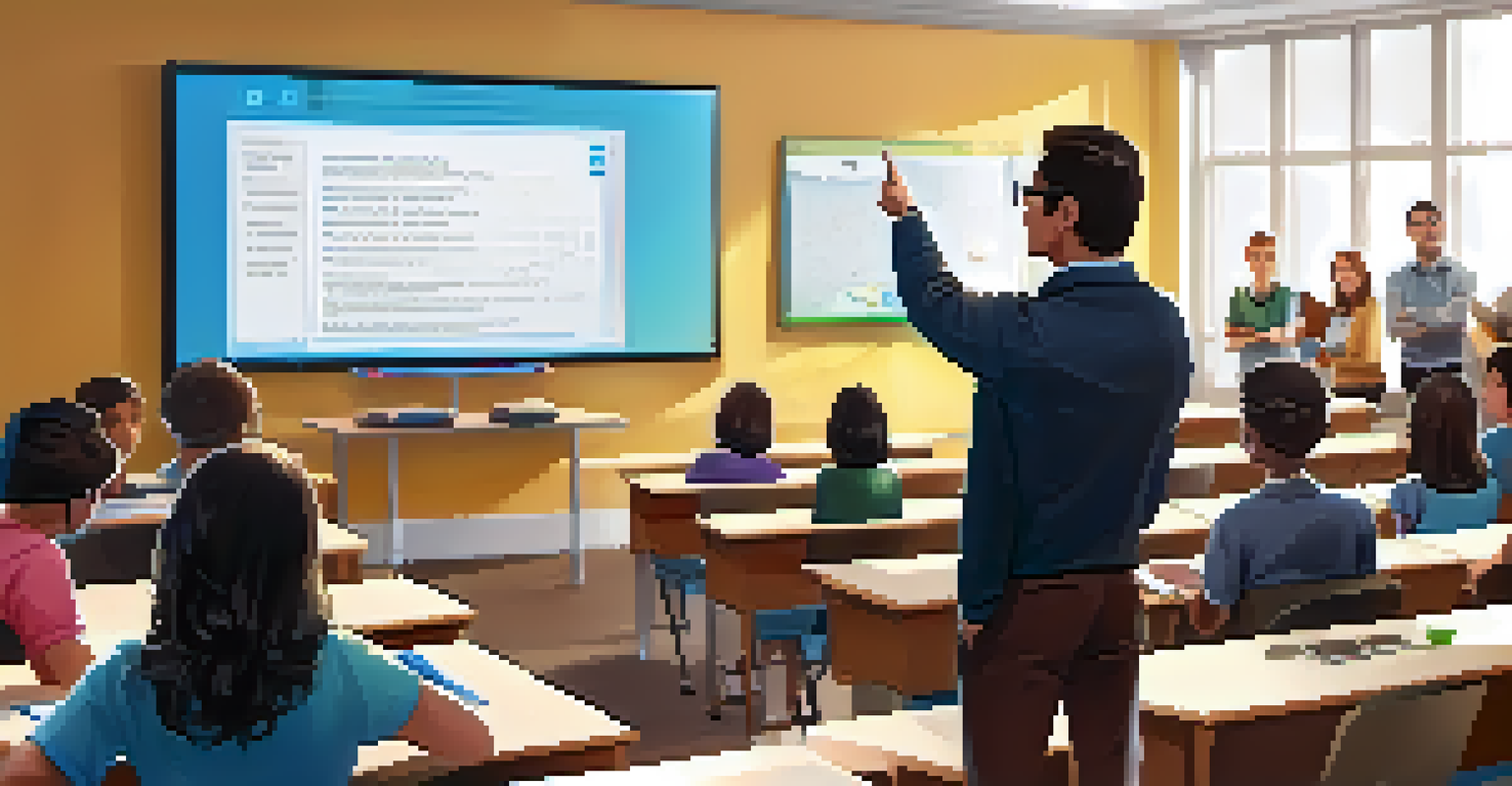Implementing Flipped Classroom in Blended Learning Models

Understanding the Flipped Classroom Concept
The flipped classroom is an innovative teaching model where traditional learning roles are reversed. Instead of introducing new material in class, students engage with lectures or readings at home. This allows classroom time to be focused on interactive discussions and hands-on activities, fostering deeper understanding.
Education is not the filling of a pail, but the lighting of a fire.
Think of it like preparing a meal: instead of just watching a cooking show, you gather your ingredients and practice the recipe yourself. This way, when you come together with others, you can share experiences, troubleshoot, and refine your skills collectively.
In blended learning, the flipped classroom fits seamlessly, as it emphasizes the importance of both online and face-to-face interactions. By shifting the lecture outside the classroom, educators can maximize the benefits of in-person time for collaborative learning.
Benefits of the Flipped Classroom Model
There are numerous advantages to implementing a flipped classroom approach. One major benefit is that it promotes active learning. Students take charge of their education by engaging with materials at their own pace, allowing for better retention and understanding of the content.

Another significant advantage is the increased interaction during class time. With fewer lectures, students can participate in discussions, ask questions, and collaborate on projects, which leads to a more dynamic and engaging learning environment.
Flipped Classroom Enhances Learning
This innovative model promotes active learning by allowing students to engage with materials at their own pace before participating in dynamic classroom activities.
Additionally, the model supports diverse learning styles. Visual learners can watch videos, auditory learners can listen to podcasts, and kinesthetic learners can engage in hands-on activities, making education more inclusive and effective for everyone.
Integrating Technology in the Flipped Classroom
Technology plays a crucial role in the flipped classroom model. Tools such as educational videos, interactive quizzes, and online forums can facilitate learning outside of the traditional classroom setting. Platforms like YouTube and educational websites offer a wealth of resources that cater to various subjects and topics.
The capacity to learn is a gift; the ability to learn is a skill; the willingness to learn is a choice.
Consider using learning management systems (LMS) that allow educators to share materials easily and track student progress. This not only streamlines communication but also ensures that all students have access to the same high-quality resources.
Moreover, technology can enhance the in-class experience. Tools like live polling or collaborative documents can engage students in real-time, making discussions more interactive and ensuring that every voice is heard during class activities.
Designing Effective Learning Materials
Creating effective learning materials is key to a successful flipped classroom. Educators should focus on clarity and engagement when developing content. Short, focused videos or readings that highlight essential concepts can keep students interested and motivated.
For example, instead of lengthy lectures, a series of brief instructional videos can break down complex topics into digestible segments. This approach allows students to revisit challenging concepts as needed, reinforcing their understanding.
Technology Supports Classroom Success
Utilizing tools like educational videos and interactive quizzes facilitates effective learning outside the classroom and enhances in-class engagement.
Additionally, incorporating a variety of formats—like podcasts, infographics, and interactive simulations—can cater to different learning preferences. The goal is to create a rich, diverse learning experience that keeps students excited about the material.
Setting Up a Supportive Classroom Environment
A supportive classroom environment is essential for the flipped classroom model to thrive. Teachers should establish clear expectations and guidelines for both in-class and out-of-class activities. This helps students understand their roles and encourages them to take responsibility for their learning.
Creating an open atmosphere where students feel comfortable asking questions or expressing confusion is vital. This can be achieved through regular feedback and fostering a culture of respect and collaboration among peers.
Moreover, providing additional support resources, such as tutoring sessions or study groups, can help students who may struggle with the self-directed aspect of the flipped model. By ensuring that students feel supported, educators can enhance their overall learning experience.
Assessing Student Learning in a Flipped Classroom
Assessment in a flipped classroom should be continuous and varied. Traditional testing methods can be supplemented with formative assessments, such as quizzes or peer evaluations, to gauge student understanding throughout the learning process. This approach helps identify areas of difficulty in real-time.
Incorporating project-based assessments can also be effective, as they allow students to demonstrate their understanding through practical applications. For example, instead of a standard test, students might work in groups to create a presentation on a topic they explored during the flipped learning phase.
Assessments Foster Continuous Growth
In a flipped classroom, varied assessments provide meaningful feedback, encouraging a mindset of continuous improvement rather than just focusing on final results.
Ultimately, the goal of assessment in a flipped classroom is to provide meaningful feedback that promotes growth. By focusing on learning progress rather than just final results, educators can encourage a mindset of continuous improvement.
Challenges and Solutions in Flipped Classrooms
While flipped classrooms offer many benefits, they also present challenges that educators must navigate. One common issue is ensuring that all students have access to the necessary technology and resources at home. Disparities in access can create inequities in learning opportunities.
To address this, schools can provide support, such as lending devices or offering access to resources within school hours. Additionally, educators can record lessons and provide offline materials for students who may not have reliable internet access.

Another challenge is student motivation and accountability. Some students may struggle to keep up with the self-paced learning model. Regular check-ins and setting clear expectations can help keep students engaged and accountable for their learning, ensuring that everyone stays on track.